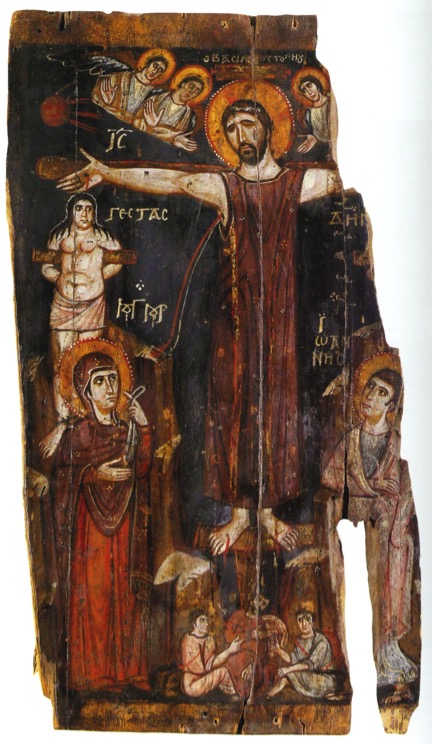The jacket of this sumptuously illustrated book shows a detail from the door panel of a shrine in the J. Paul Getty Museum in Malibu depicting the Egyptian god Serapis, which, despite the spiky cluster of olive leaves behind his head (doing duty for the crown of thorns?), many a modern eye would take for Christ. This misprision could no doubt be ascribed to the wealth and variety of post-medieval ‘portraits’ of Jesus. But for the author of the book at hand the relationship is one of essence.
 Since The Clash of Gods: A Reinterpretation of Early Christian Art (Princeton, 1993), where Thomas Mathews separated much early Christian iconography from images of the Roman emperor, he has been well-known for swimming against the tide or, as it is put in scholarly circles, revisionism. This attitude persists in his new book, in which he displays not just academic cussedness, but unfurls a mass of archaeological and textual data. Mathews traces the course of panel painting from ‘lost’ ancient Greek examples, through a tranche of specimens of the genre from Roman Egypt, a host of Byzantine works in a great variety of materials, and across the Adriatic to Cimabue and Duccio.
Since The Clash of Gods: A Reinterpretation of Early Christian Art (Princeton, 1993), where Thomas Mathews separated much early Christian iconography from images of the Roman emperor, he has been well-known for swimming against the tide or, as it is put in scholarly circles, revisionism. This attitude persists in his new book, in which he displays not just academic cussedness, but unfurls a mass of archaeological and textual data. Mathews traces the course of panel painting from ‘lost’ ancient Greek examples, through a tranche of specimens of the genre from Roman Egypt, a host of Byzantine works in a great variety of materials, and across the Adriatic to Cimabue and Duccio.
Thus his discussion transcends by far the vexed chronological question that interests most specialists: the interval between the 2nd–4th century AD paintings on wood from Karanis, Assiout, and Theadelphia that are the topic of Mathews’ first chapter and the earliest (6th-century) icons, which are still produced by the same means at Mount Sinai and in churches in Rome. These are fully taken into account, along with the sizeable number of examples scattered from Berlin to Berkeley, California.

Crucifixion with the Dead Christ (9th/10th century)
Mathews’ argument is clear: ‘The corpus of early Christian icons constitutes a kind of echo or mirror of the corpus of pagan panel paintings of Roman Egypt, sharing many of the same conventions.’ And his readiness to engage in polemic (he names names in the body of the text; a more nuanced set of responses would have been more useful) is undiminished. He rebukes ‘a sizable contingent of scholars’ for excluding from their studies on the image of the Virgin ‘earlier evidence of the Marian cult in the Gospels and Proevangelium [sic], an omission that seriously impoverishes the narrative of the Mother of God’. In his desire to link early icon painting to the ancient world Mathews may sometimes go too far. Thus the properly draped Christ, as dead as a clothes-peg, on a famous icon of the Crucifixion at Mount Sinai is said to ‘belong to the pre-Christian vocabulary of the Classical Greek nude’.
The core of the book lies in the meticulous examination of individual panels – due in large part to Norman Muller, a painting conservator at the Princeton University Art Museum – their pigments and medium (‘Encaustic is common in the mummy portraits but not in the corpus of gods, which are typically in egg tempera’), and their framing. This necessary scrutiny extends to the early 6th-century marble templon barrier, now broken up, of the church of St Polyeuktos in the Archaeological Museum in Istanbul, and especially its Mary panel, the reverse of which, in an unpublished photograph, shows not only how these were pried loose by iconoclast hands, but also how they were originally attached. He says that the reliefs have been ‘unaccountably neglected in Byzantine studies for over half a century, even while in the bibliography he cites Lawrence Nees’ important paper of 1983 on their iconography. Expanding his gaze chronologically and geographically, Mathews makes splendid use of the wall paintings in the Red Monastery at Deir Anba Bishai in Egypt, conserved since 2002, although his account of Ezekiel’s vision introduces some later confusion into his discussion of the hexapteryga – the sloe-eyed, six-winged celestial creatures who support God in the pendentives of the Hagia Sophia in Constantinople, whom he describes as cherubim. On the same page, another lapse (of the pen or of memory?) labels the Palazzo Venezia in Rome, where there is a great shrine-like ivory triptych, the Palazzo Vecchio. The liturgical hymn known as the Cherubicon is variously spelt within the space of a single paragraph.
Nonetheless, if his angelology and proofreading occasionally go awry, few, particularly in the art-historical community, will care about these oddities in the face of the challenges with which Mathews has presented us. Unless and until those who oppose the idea of cohesion and continuity between the pagan works in question and their Christian successors can show that Mathews traduces the history of material culture and of ideas, his book will remain an essential, if controversial contribution to the debate.
The Dawn of Christian Art in Panel Paintings and Icons by Thomas F. Mathews with Norman E. Muller is published by Getty Publications.
From the June issue of Apollo. Preview and subscribe here.














![Masterpiece [Re]discovery 2022. Photo: Ben Fisher Photography, courtesy of Masterpiece London](http://zephr.apollo-magazine.com/wp-content/uploads/2022/07/MPL2022_4263.jpg)
‘Like landscape, his objects seem to breathe’: Gordon Baldwin (1932–2025)